A Computational Model of Watermark Algorithmic Robustness Capable of Resisting Image Cropping for Remote Sensing Images
Abstract
1. Introduction
2. Methodology
2.1. Basic Watermarking Procedure
2.1.1. Watermark Synchronization
2.1.2. Robustness Evaluation Index
2.2. The Principles of Robustness Computation
2.2.1. Principles of Watermarking Algorithm
2.2.2. Principles of Image Cropping Attack
2.3. Probability-Based Robustness Index
2.4. Robustness Computation Method
2.4.1. Introduction of the Auxiliary Function
2.4.2. Computation of the Auxiliary Function
2.4.3. Computation of Robustness Index
3. Experimental Results and Analysis
3.1. Materials
3.2. Verification of Proposed Model
3.2.1. Experimental Results
3.2.2. Statistics Results
3.2.3. Efficiency Results
3.3. Deductions from Proposed Model
3.3.1. The Relationship between Robustness R and Repeat Times N
3.3.2. The Relationship between Robustness R and Watermark Information Length L
4. Discussion
5. Conclusions
Author Contributions
Funding
Conflicts of Interest
Appendix A. MATLAB Code of the Proposed Robustness Computation Model
Code file name: OPDrawDeleteRobustness.m
Contents:
function [DeleteRate, Prob] = OPDrawDeleteRobustness(WatermarkLength, RepeatTimes,
NCThreshold, DeleteStartRate, DeleteEndRate, DeleteIntervalRate)
tic;
TotalWMBits = WatermarkLength × RepeatTimes;
DeleteRate = DeleteStartRate:DeleteIntervalRate:DeleteEndRate;
Count = (DeleteEndRate − DeleteStartRate)/DeleteIntervalRate + 1;
Count = round(Count);
Prob = ones(1, Count);
parfor i = 1:Count %parallel computing to improve the efficiency
TempRate = DeleteRate(i);
DeleteBits = round(TotalWMBits × TempRate);
CurR = OPCalDetectSucceesPro(WatermarkLength, RepeatTimes, DeleteBits,
NCThreshold);
Prob(i) = CurR;
end
plot(DeleteRate, Prob);
toc;
end
Code file name: OPCalDetectSuccessPro.m
Contents:
function DetectSuccessPro = OPCalDetectSucceesPro(WatermarkLength, RepeatTimes, DeleteBits,
NCThreshold)
L = WatermarkLength;
N = RepeatTimes;
D = DeleteBits;
X = ceil(L × NCThreshold);
if D > = L × N
DetectSuccessPro = 0;
elseif D < N
DetectSuccessPro = 1;
else
for i = X:L
tempPro = OPCalMPProbDirectly(i, N, D – N × (L − i), L, N, D);
Sum = Sum + tempPro;
end
DetectSuccessPro = Sum;
if DetectSuccessPro < 0
DetectSuccessPro = 0;
end
if DetectSuccessPro > 1
DetectSuccessPro = 1;
end
end
end
Code file name: OPCalMPProbDirectly.m
Code:
function Result = OPCalMPProbDirectly(dL, dN, dD, dtotalL, dtotalN, dtotalD)
%mp is the data type of Multiprecision Computing Toolbox for MATLAB (detailed
information in www.advanpix.com), which is used to calculate the probability with
sufficient precision.
L = mp(dL);
N = mp(dN);
D = mp(dD);
totalL = mp(dtotalL);
totalN = mp(dtotalN);
totalD = mp(dtotalD);
totalbits = totalL × totalN;
if D < 0
Result = 0;
elseif D = = 0
Result = exp(gammaln(totalL + 1) − gammaln(L + 1) − gammaln(totalL − L + 1) − (gammaln(totalbits + 1) − gammaln(totalD + 1) − gammaln(totalbits − totalD + 1)));
elseif D < N
Result = exp(gammaln(totalL + 1) − gammaln(L + 1) − gammaln(totalL − L + 1) + gammaln(L × N + 1) − gammaln(D + 1) − gammaln(L × N − D + 1) − (gammaln(totalbits + 1) − gammaln(totalD + 1) − gammaln(totalbits − totalD + 1)));
elseif D > L × (N − 1)
Result = 0;
else
MaxCrackColCount = fix(D/N);
sum = exp(gammaln(totalL + 1) − gammaln(L + 1) − gammaln(totalL − L + 1) + gammaln(L × N + 1) − gammaln(D + 1) − gammaln(L × N − D + 1) − (gammaln(totalbits + 1) − gammaln(totalD + 1) − gammaln(totalbits − totalD + 1)));
for i = 1:MaxCrackColCount
temp = (−1)^i × exp(gammaln(totalL + 1) − gammaln(L + 1) − gammaln(totalL − L + 1) + gammaln(L + 1) − gammaln(i + 1) − gammaln(L − i + 1) + gammaln((L − i) × N + 1) − gammaln(D − N × i + 1) − gammaln((L − i) × N − D + N × i + 1) − (gammaln(totalbits + 1) − gammaln(totalD + 1) − gammaln(totalbits − totalD + 1)));
sum = sum + temp;
end
Result = sum;
end
end
References
- Vuolo, F.; Zoltak, M.; Pipitone, C.; Zappa, L.; Wenng, H.; Immitzer, M.; Weiss, M.; Baret, F.; Atzberger, C. Data service platform for sentinel-2 surface reflectance and Value-Added products: System use and examples. Remote Sens. 2016, 8, 938. [Google Scholar] [CrossRef]
- Begue, A.; Arvor, D.; Bellon, B.; Betbeder, J.; de Abelleyra, D.; Ferraz, R.; Lebourgeois, V.; Lelong, C.; Simoes, M.; Veron, S.R. Remote sensing and cropping practices: A review. Remote Sens. 2018, 10, 99. [Google Scholar] [CrossRef]
- Murray, N.J.; Keith, D.A.; Bland, L.M.; Ferrari, R.; Lyons, M.B.; Lucas, R.; Pettorelli, N.; Nicholson, E. The role of satellite remote sensing in structured ecosystem risk assessments. Sci. Total Environ. 2018, 619, 249–257. [Google Scholar] [CrossRef] [PubMed]
- Barni, M.; Bartolini, F.; Cappellini, V.; Magli, E.; Olmo, G.; Zanini, R. Copyright protection of remote sensing imagery by means of digital watermarking. Sens. Syst. Next-Gener. Satell. V 2001, 4540, 565–576. [Google Scholar] [CrossRef]
- Chi, M.M.; Plaza, A.; Benediktsson, J.A.; Sun, Z.Y.; Shen, J.S.; Zhu, Y.Y. Big data for remote sensing: Challenges and opportunities. Proc. IEEE 2016, 104, 2207–2219. [Google Scholar] [CrossRef]
- Chang, C.; Lee, Y.; Chang, A.; Huang, P.S.; Tu, T. StarMarker-a fast and robust RGB-based saturation watermarking system for pan-sharpened IKONOS and QuickBird imagery. Opt. Eng. 2006, 45, 56202. [Google Scholar] [CrossRef]
- Lee, H.; Im, D.; Lee, H. Error concealment technique of satellite imagery transmission through information hiding. IEICE Trans. Inf. Syst. 2007, E90D, 1881–1884. [Google Scholar] [CrossRef]
- Benzid, R. Near-lossless spread spectrum watermarking for multispectral remote sensing images. J. Appl. Remote Sens. 2007, 1, 13501. [Google Scholar] [CrossRef]
- Purna Kumari, B.; Subramanyam Rallabandi, V.P. Modified patchwork-based watermarking scheme for satellite imagery. Signal Process. 2008, 88, 891–904. [Google Scholar] [CrossRef]
- Zhu, P.; Jia, F.; Zhang, J. A copyright protection watermarking algorithm for remote sensing image based on binary image watermark. Optik 2013, 124, 4177–4181. [Google Scholar] [CrossRef]
- Hsu, P.; Chen, C. A robust digital watermarking algorithm for copyright protection of aerial photogrammetric images. Photogramm. Rec. 2016, 31, 51–70. [Google Scholar] [CrossRef]
- Craver, S.; Memon, N.; Yeo, B.L.; Yeung, M.M. Resolving rightful ownerships with invisible watermarking techniques: Limitations, attacks, and implications. IEEE J. Sel. Areas Commun. 1998, 16, 573–586. [Google Scholar] [CrossRef]
- Singh, A.K. Improved hybrid algorithm for robust and imperceptible multiple watermarking using digital images. Multimed. Tools Appl. 2017, 76, 8881–8900. [Google Scholar] [CrossRef]
- Langelaar, G.C.; Setyawan, I.; Lagendijk, R.L. Watermarking digital image and video data—A state-of-the-art overview. IEEE Signal Proc. Mag. 2000, 17, 20–46. [Google Scholar] [CrossRef]
- Cox, I.J.; Kilian, J.; Leighton, F.T.; Shamoon, T. Secure spread spectrum watermarking for multimedia. IEEE Trans. Image Process. 1997, 6, 1673–1687. [Google Scholar] [CrossRef] [PubMed]
- Zope-Chaudhari, S.; Venkatachalam, P.; Buddhiraju, K.M. Secure dissemination and protection of multispectral images using Crypto-Watermarking. IEEE J. Sel. Top. Appl. Earth Obs. 2015, 8, 5388–5394. [Google Scholar] [CrossRef]
- AL-Mansoori, S.; Kunhu, A. Hybrid DWT-DCT-Hash function based Digital Image Watermarking for Copyright Protection and Content Authentication of DubaiSat-2 Images. SPIE Remote Sens. 2014, 9247. [Google Scholar] [CrossRef]
- Heidari, S.; Naseri, M. A novel LSB based quantum watermarking. Int. J. Theor. Phys. 2016, 55, 4205–4218. [Google Scholar] [CrossRef]
- Xu, W.; Xu, H.; Luo, Y.; Li, T.; Shi, Y. Optical watermarking based on single-shot-ptychography encoding. Opt. Express. 2016, 24, 27922–27936. [Google Scholar] [CrossRef] [PubMed]
- Gashnikov, M.V.; Glumov, N.I.; Kuznetsov, A.V.; Mitekin, V.A.; Myasnikov, V.V.; Sergeev, V.V. Hyperspectral remote sensing data compression and protection. Comput. Opt. 2016, 40, 689–712. [Google Scholar] [CrossRef]
- Lee, M.; Ting, P. Photograph watermarking. Multimed. Tools Appl. 2016, 75, 16173–16189. [Google Scholar] [CrossRef]
- Yang, C. Robust high-capacity watermarking scheme based on Euclidean norms and quick coefficient alignment. Multimed. Tools Appl. 2017, 76, 1455–1477. [Google Scholar] [CrossRef]
- Rani, A.; Raman, B. An image copyright protection system using chaotic maps. Multimed. Tools Appl. 2017, 76, 3121–3138. [Google Scholar] [CrossRef]
- Mousavi, S.M.; Naghsh, A.; Manaf, A.A.; Abu-Bakar, S. A robust medical image watermarking against salt and pepper noise for brain MRI images. Multimed. Tools Appl. 2017, 76, 10313–10342. [Google Scholar] [CrossRef]
- Petitcolas, F.A.P.; Anderson, R.J.; Kuhn, M.G. Attacks on Copyright Marking Systems. In International Workshop on Information Hiding; Springer: Berlin/Heidelberg, Germany; Portland, OR, USA, 1998; pp. 218–238. [Google Scholar]
- Petitcolas, F.A.P. Watermarking schemes evaluation. IEEE Signal Proc. Mag. 2000, 17, 58–64. [Google Scholar] [CrossRef]
- Kim, H.C.; Ogunleye, H.; Guitart, O.; Delp, E.J. The watermark evaluation testbed (WET). In Proceedings of the SPIE—The International Society for Optical Engineering, Denver, CO, USA, 2–3 August 2004; pp. 236–248. [Google Scholar] [CrossRef]
- Iwamura, K.; Kawamura, M.; Kuribayashi, M.; Motoi, I.; Kang, H.; Gohshi, S.; Nishimura, A. Information hiding and its criteria for evaluation. IEICE Trans. Inf. Syst. 2017, E100.D, 2–12. [Google Scholar] [CrossRef]
- Kutter, M.; Petitcolas, F. A fair benchmark for image watermarking systems. In Security and Watermarking of Multimedia Contents; International Society for Optics and Photonics: Bellingham, WA, USA, 1999; Volume 3657, pp. 226–239. [Google Scholar]
- Adelsbach, A.E.; Katzenbeisser, S.; Sadeghi, A. A computational model for watermark robustness. In International Workshop on Information Hiding; Springer: Berlin/Heidelberg, Germany, 2007; pp. 145–160. [Google Scholar]
- Chen, B.; Wornell, G.W. Quantization index modulation: A class of provably good methods for digital watermarking and information embedding. IEEE Trans. Inf. Theory 2001, 47, 1423–1443. [Google Scholar] [CrossRef]
- Sun, W.; Yang, E. Closed-Form formulas for private watermarking capacities of laplacian sources with the Magnitude-Error distortion measure and under additive attacks. In International Workshop on Digital Watermarking; Springer: Berlin/Heidelberg, Germany, 2005; pp. 361–371. [Google Scholar]
- Hu, Z.; She, K.; Guo, W.; Yan, K. Analysis of watermark capacity and robustness under unintentional and steganalysis attacks. J. Inf. Comput. Sci. 2013, 10, 279–287. [Google Scholar]
- Mohammed, R.T.; Khoo, B.E. Robust reversible watermarking scheme based on wavelet-like transform. In Proceedings of the 2013 IEEE International Conference on Signal and Image Processing Applications, Melaka, Malaysia, 8–10 October 2013; pp. 354–359. [Google Scholar] [CrossRef]
- Ren, N.; Zhu, C.; Wang, Z. Blind watermarking algorithm based on mapping mechanism for remote sensing image. Acta Geod. Cartogr. Sin. 2011, 40, 623–627. [Google Scholar]
- Cui, C.; Wang, S.; Niu, X. A novel watermarking for DIBR 3D images with geometric rectification based on feature points. Multimed. Tools Appl. 2017, 76, 649–677. [Google Scholar] [CrossRef]
- Tiwari, A.; Sharma, M.; Tamrakar, R.K. Watermarking based image authentication and tamper detection algorithm using vector quantization approach. AEU-Int. J. Electron. C 2017, 78, 114–123. [Google Scholar] [CrossRef]
- Ruanaidh, J.; Pun, T. Rotation, scale and translation invariant spread spectrum digital image watermarking. Signal Process. 1998, 66, 303–317. [Google Scholar] [CrossRef]
- Wang, C.C.; Tai, S.C.; Yu, C.S. Repeating image watermarking technique by the visual cryptography. IEICE Trans. Fund. Electr. 2000, E83A, 1589–1598. [Google Scholar]
- Tsai, C.S.; Chang, C.C. A new repeating color watermarking scheme based on human visual model. EURASIP J. Appl. Signal Process. 2004, 2004, 1965–1972. [Google Scholar] [CrossRef]
- Su, Q.; Wang, G. An improved color image watermarking algorithm based on QR decomposition. Multimed. Tools Appl. 2017, 76, 707–729. [Google Scholar] [CrossRef]
- Fu, J.; Wang, K.; Xu, J. A copyright protection scheme for multiband digital remote sensing imagery. Acta Electron. Sin. 2016, 44, 732–739. [Google Scholar]
- Mitzenmacher, M.; Upfal, E. Probability and Computing: Randomized Algorithms and Probabilistic Analysis; Cambridge University Press: New York, NY, USA, 2005. [Google Scholar]

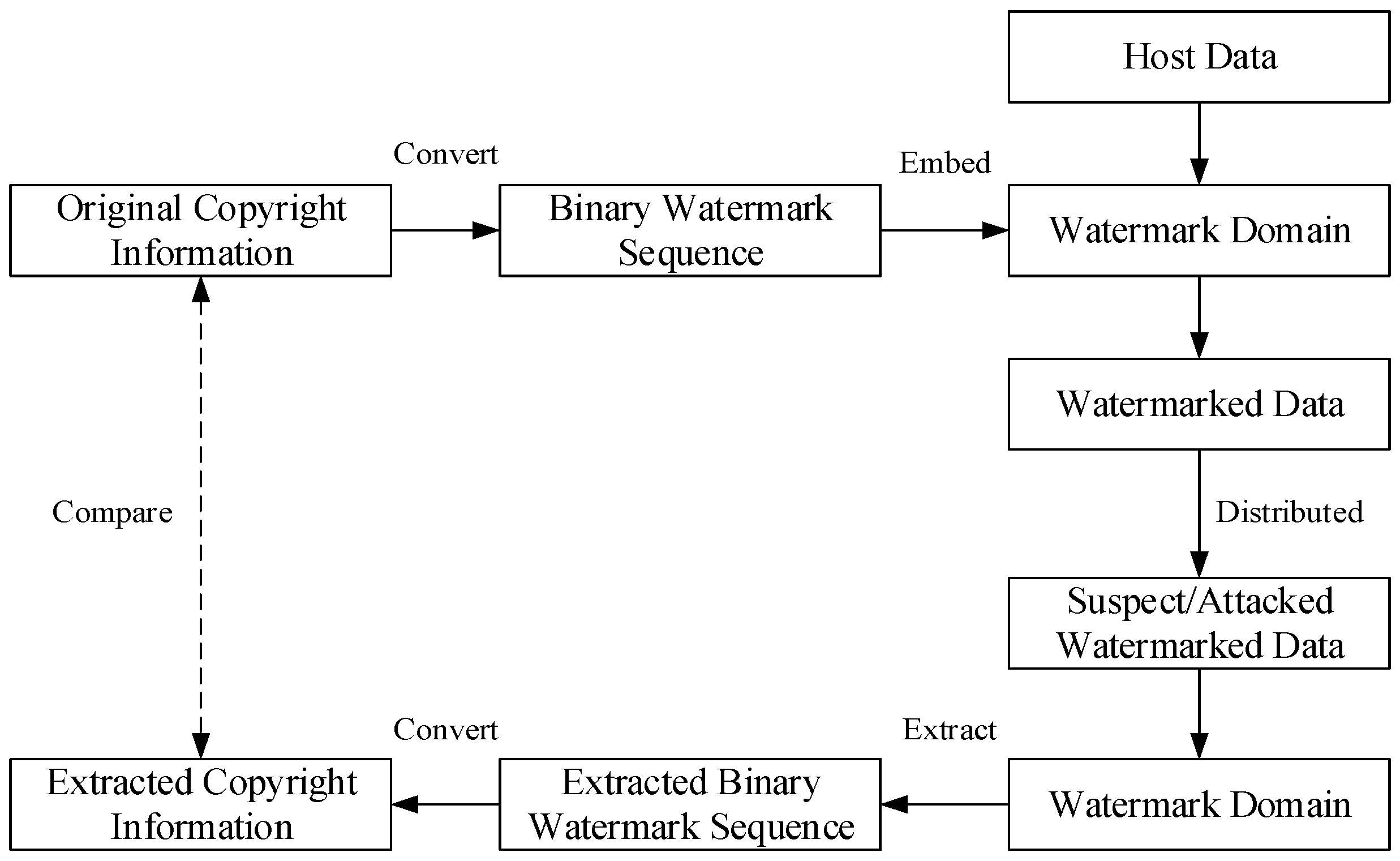

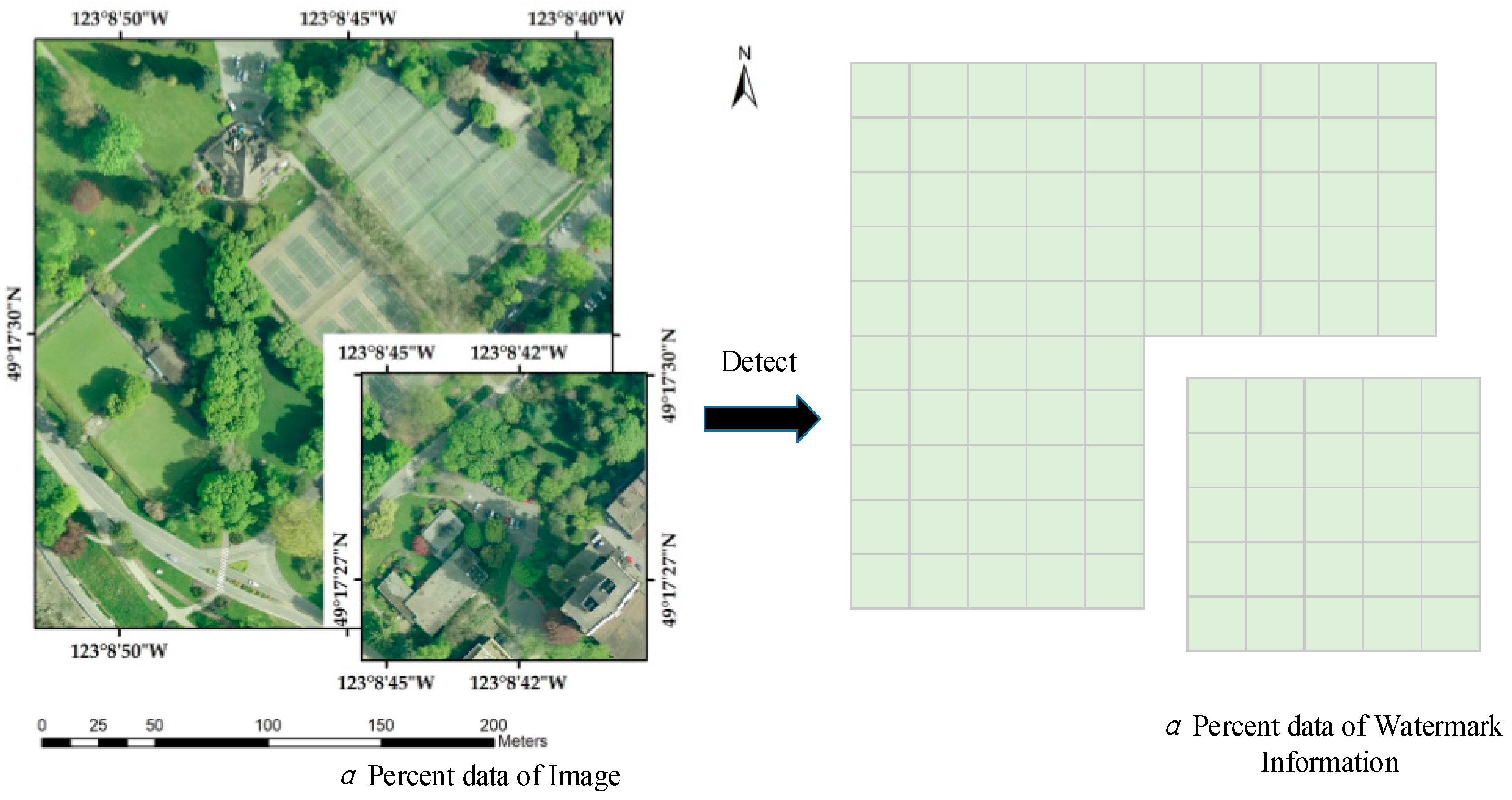
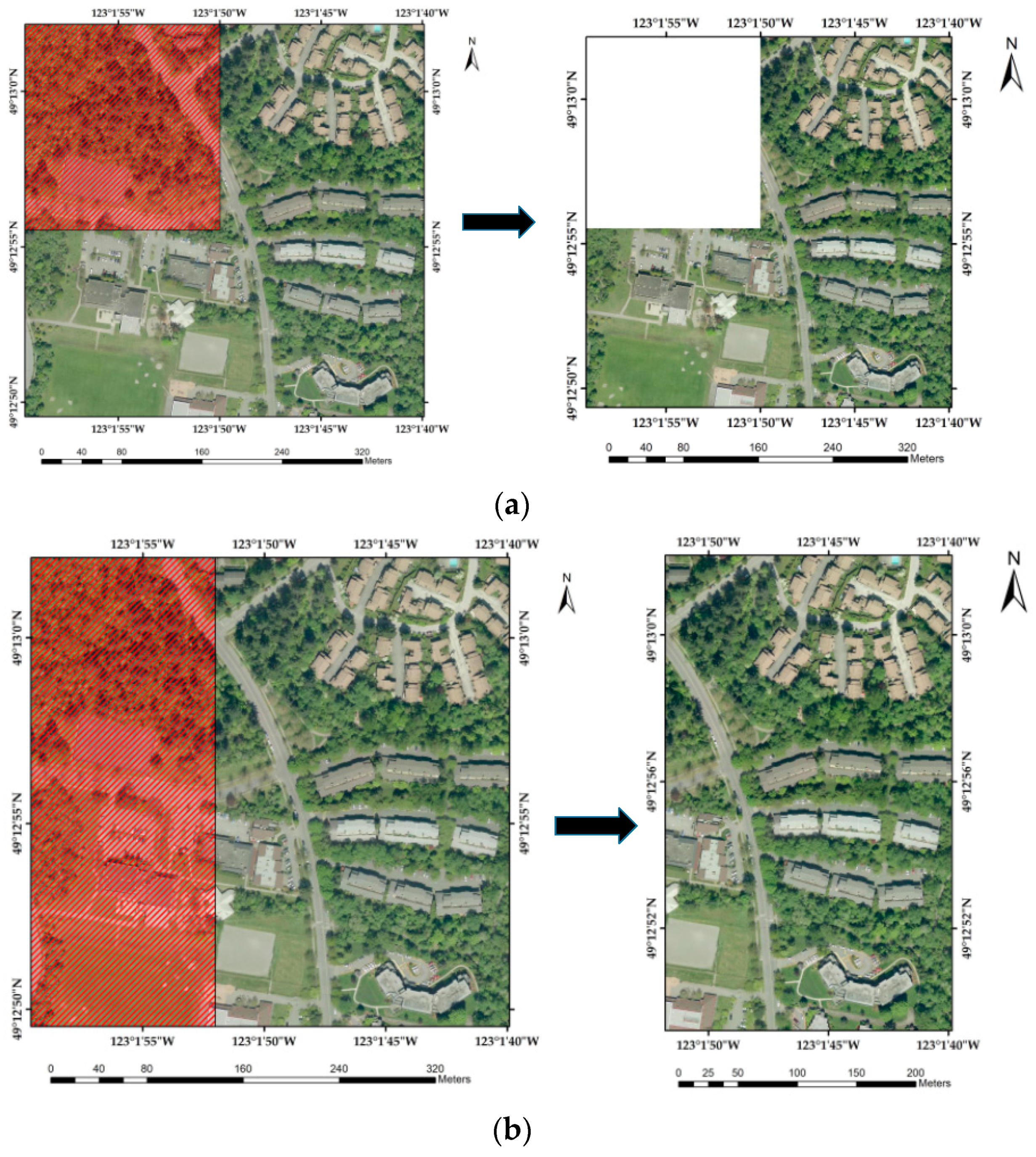
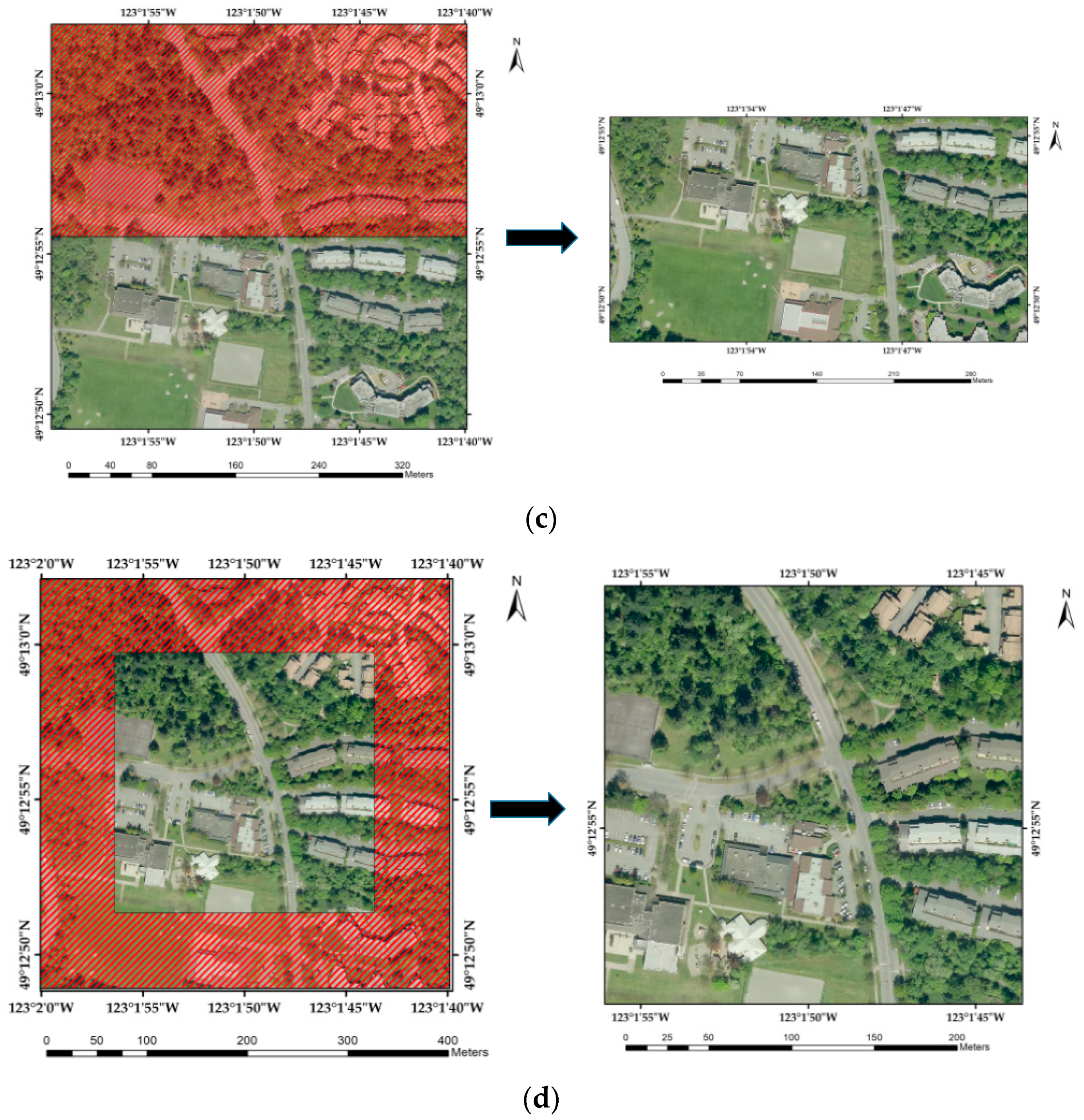
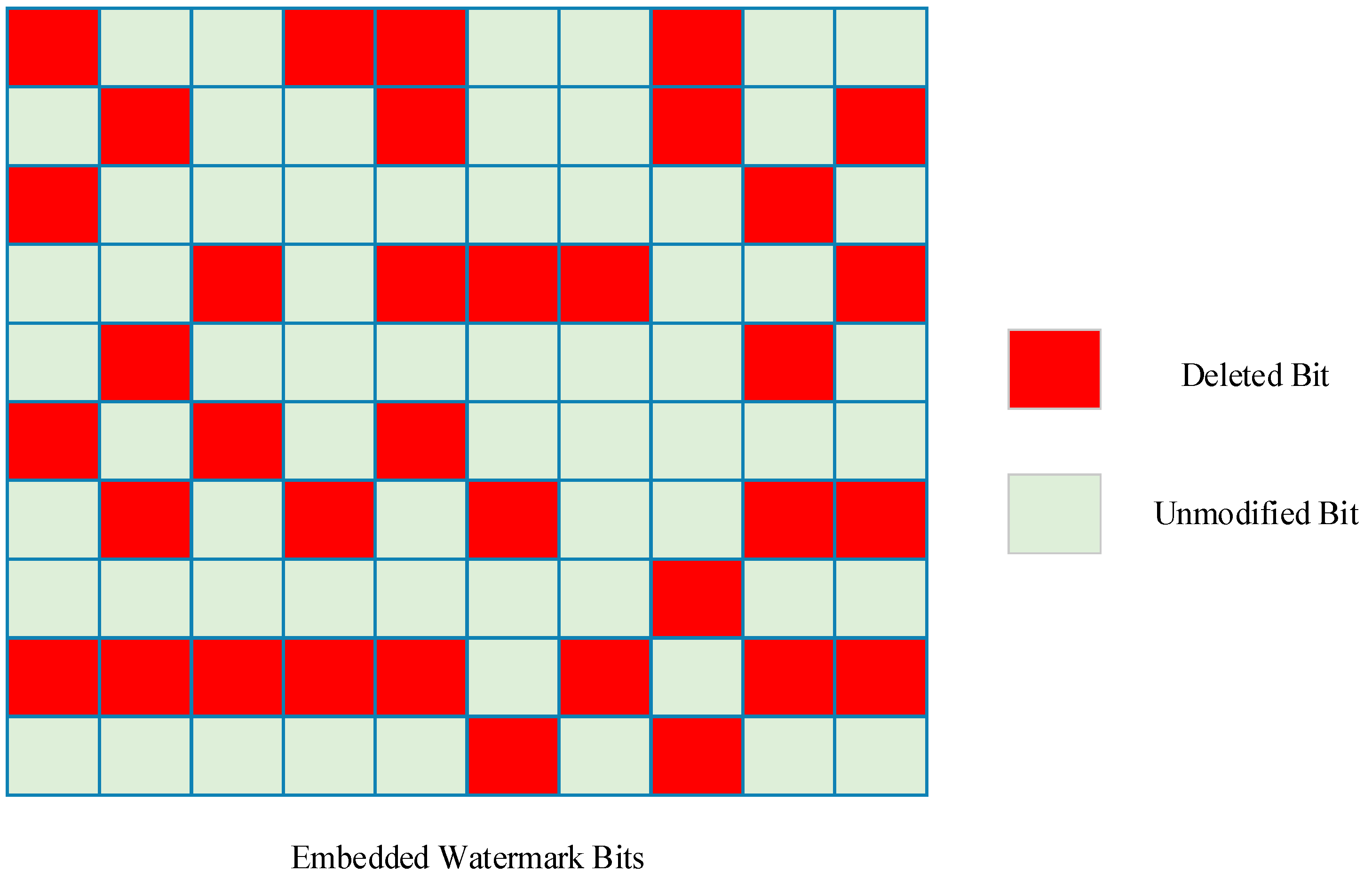

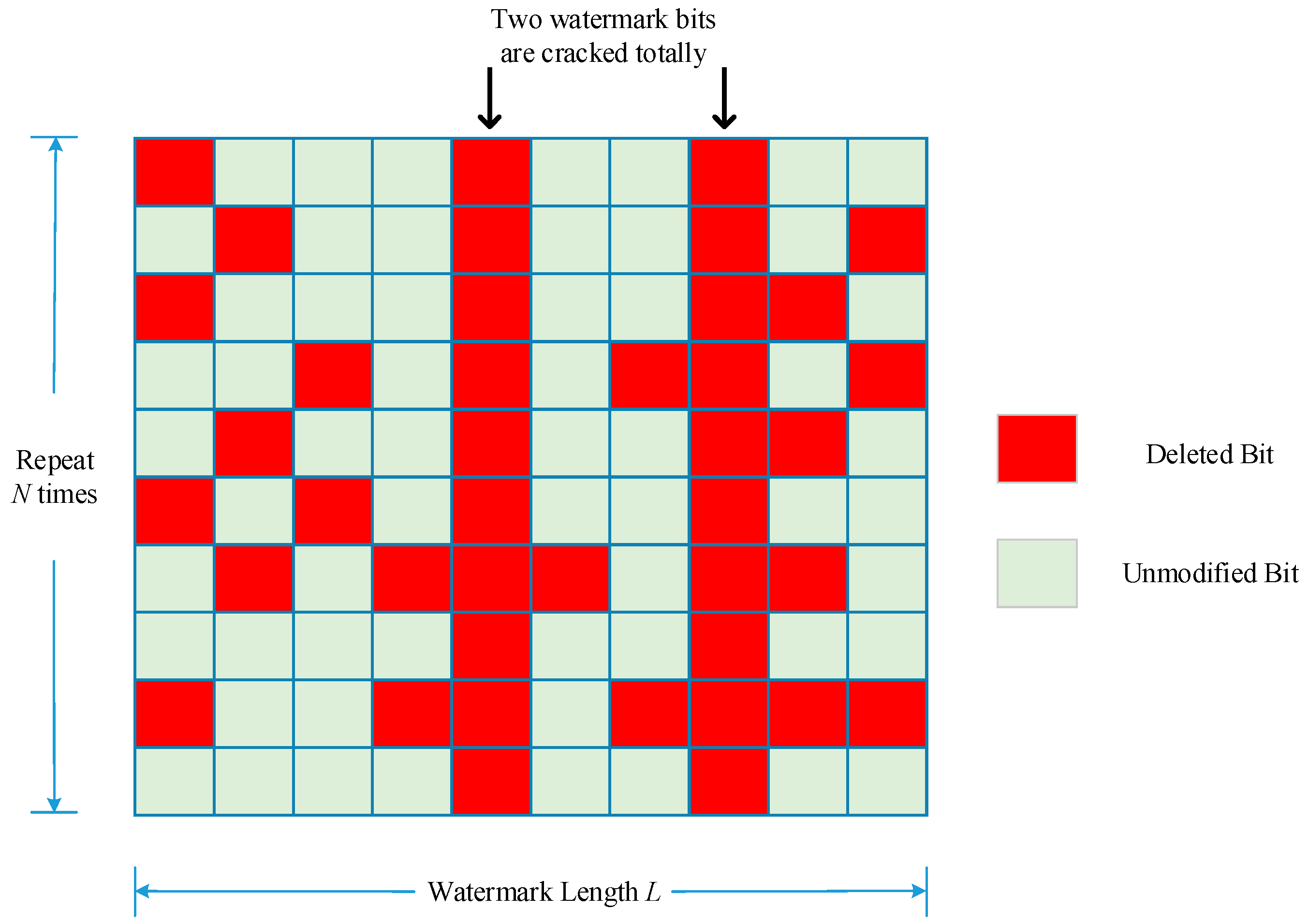
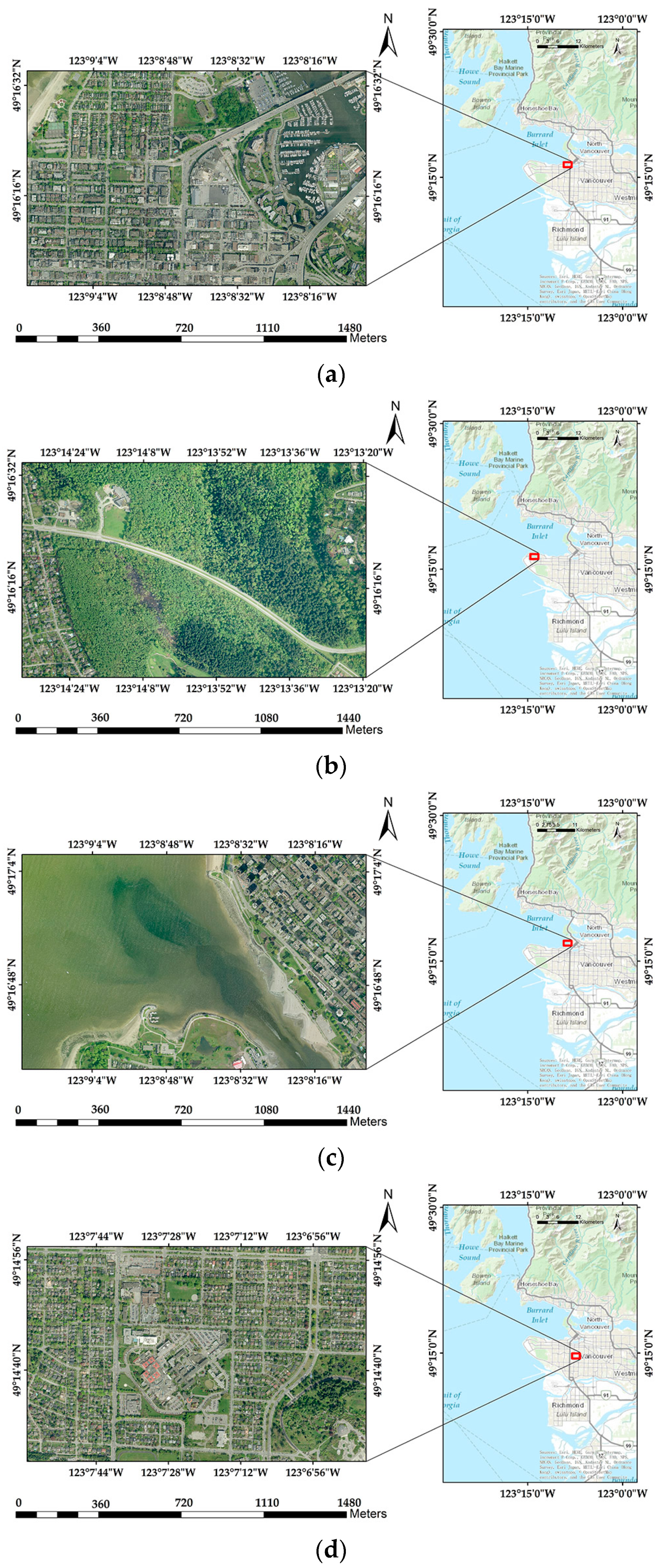
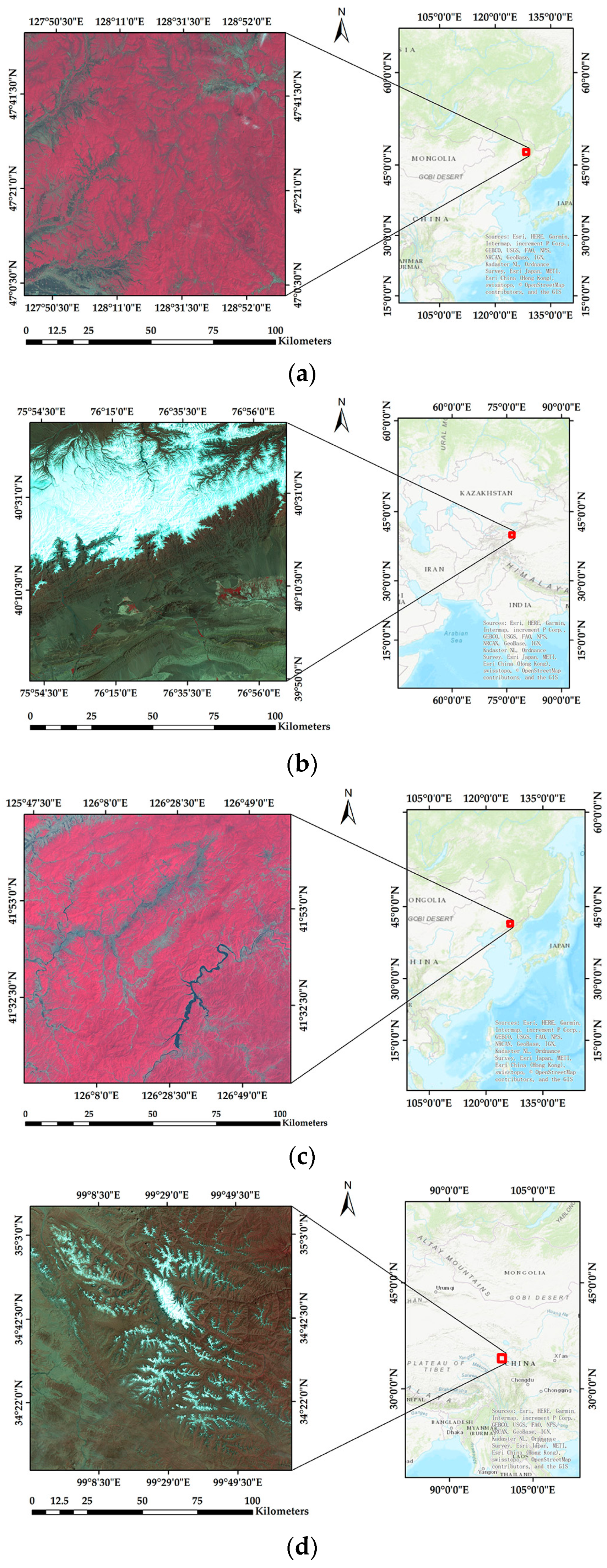
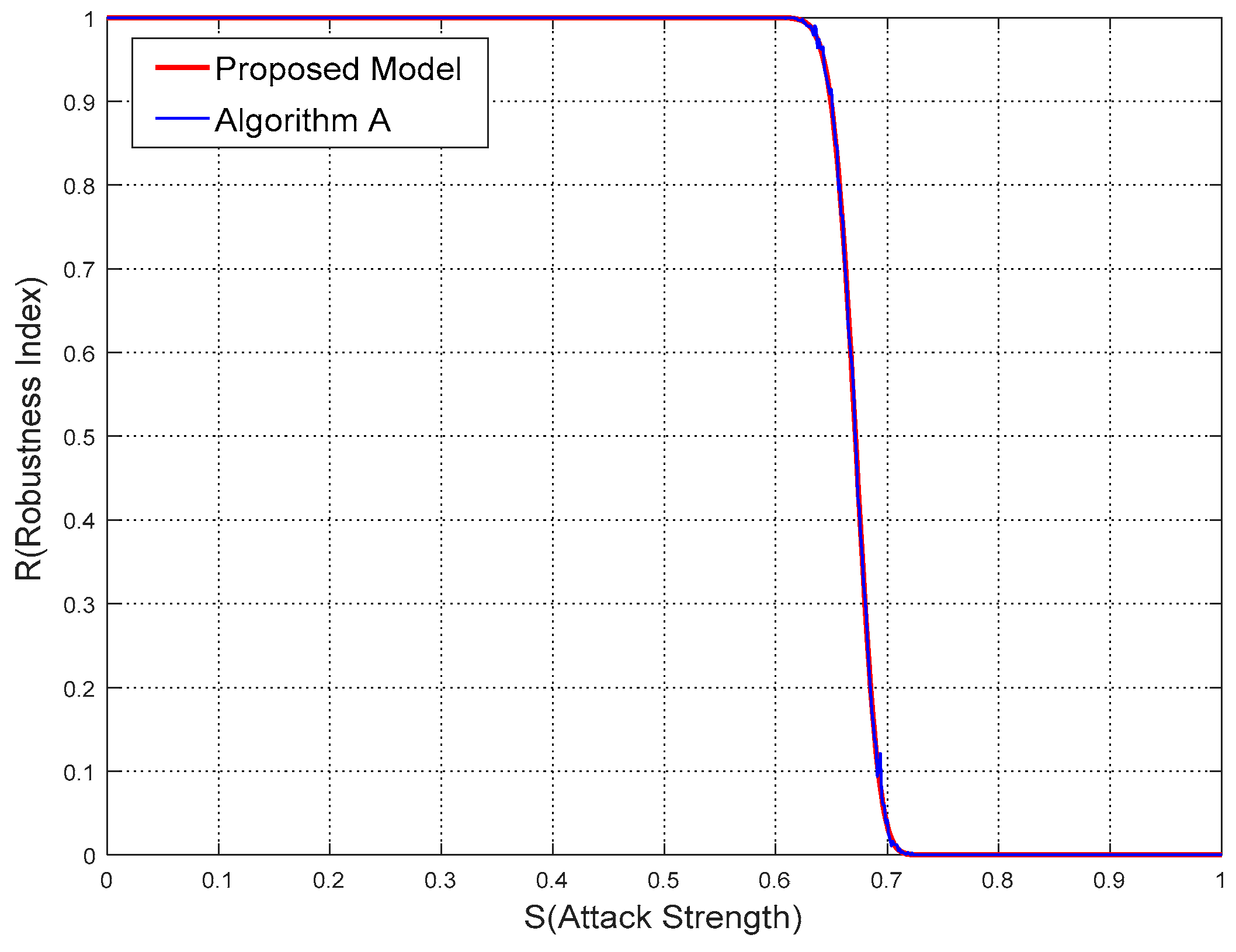


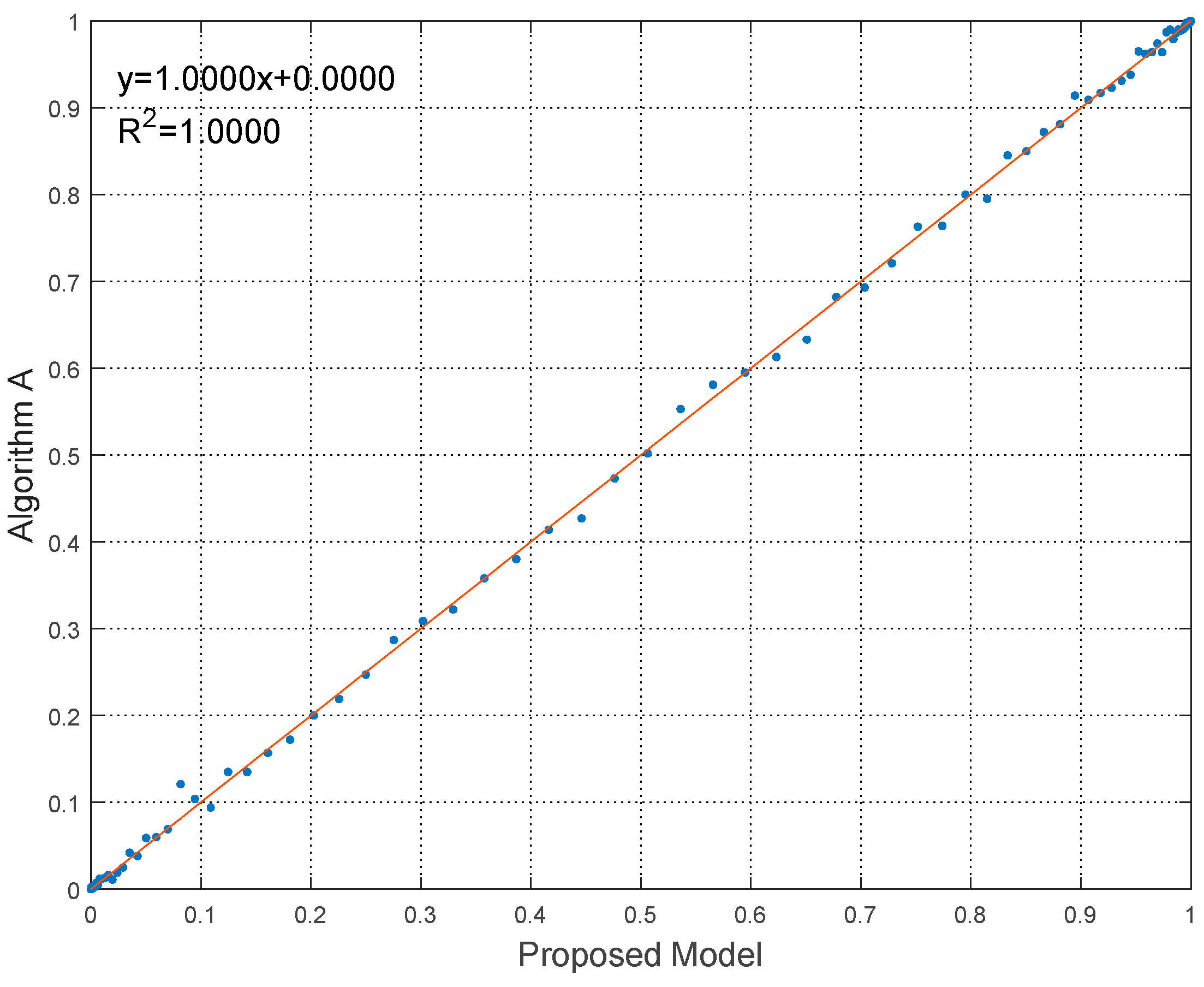

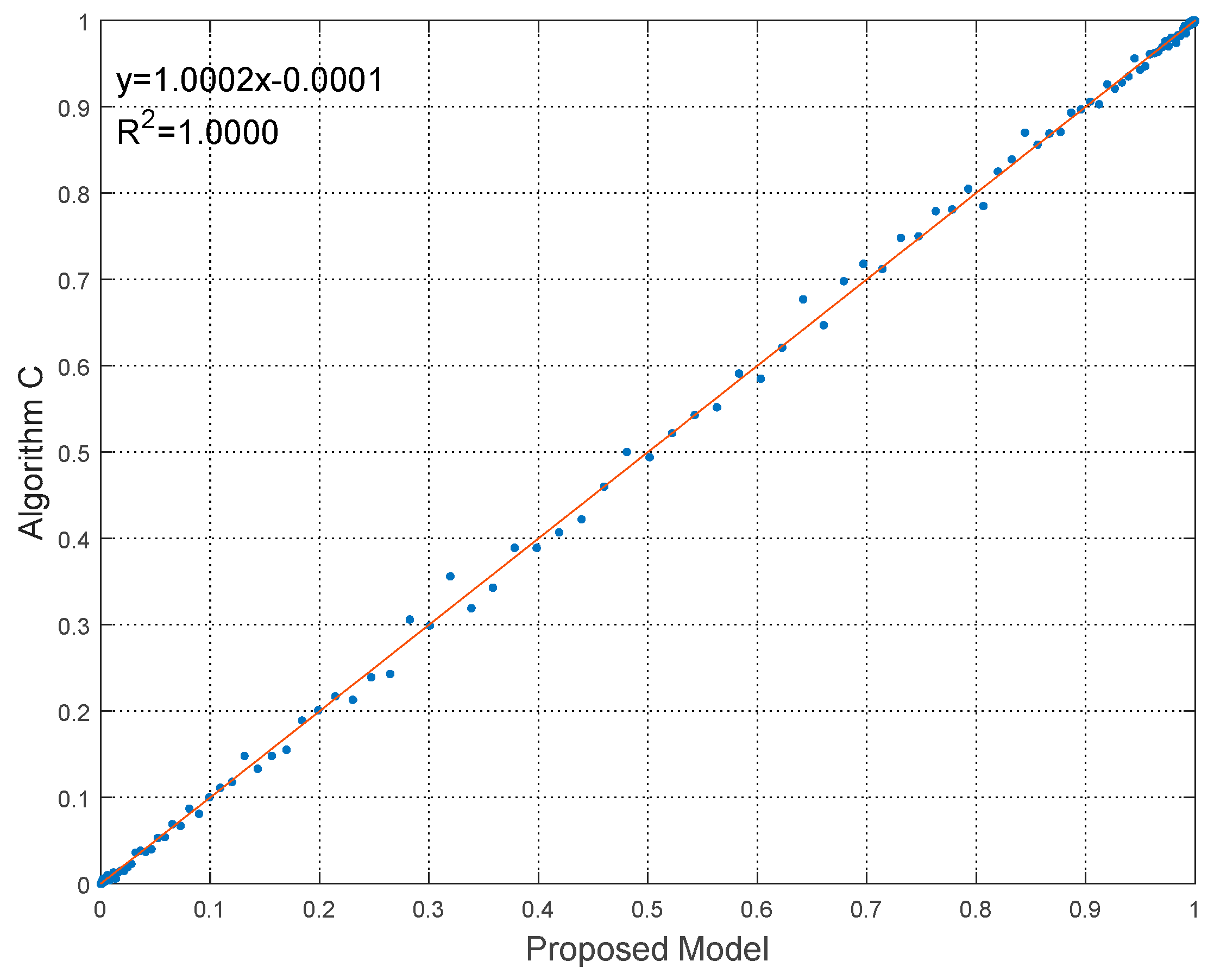
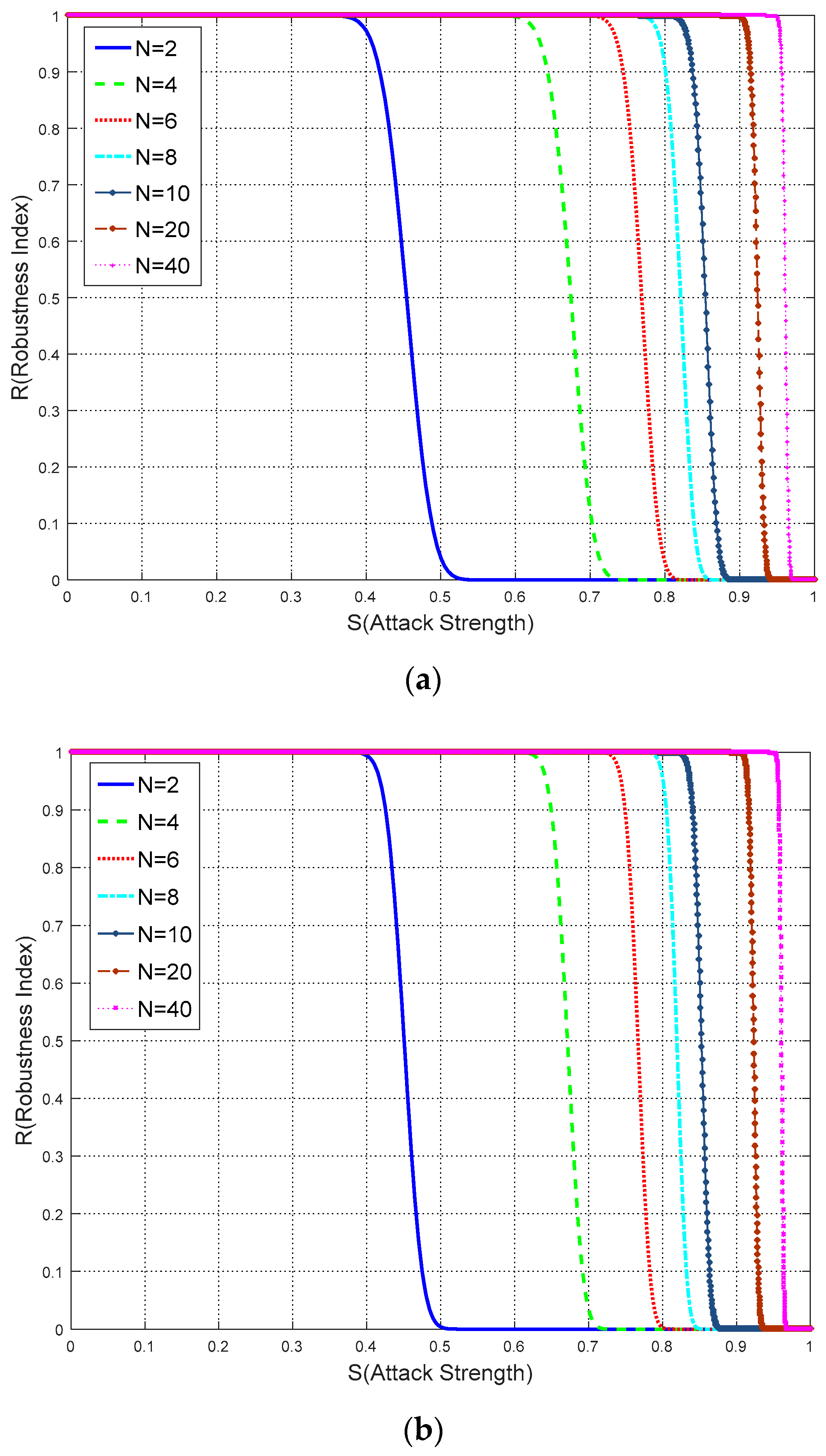
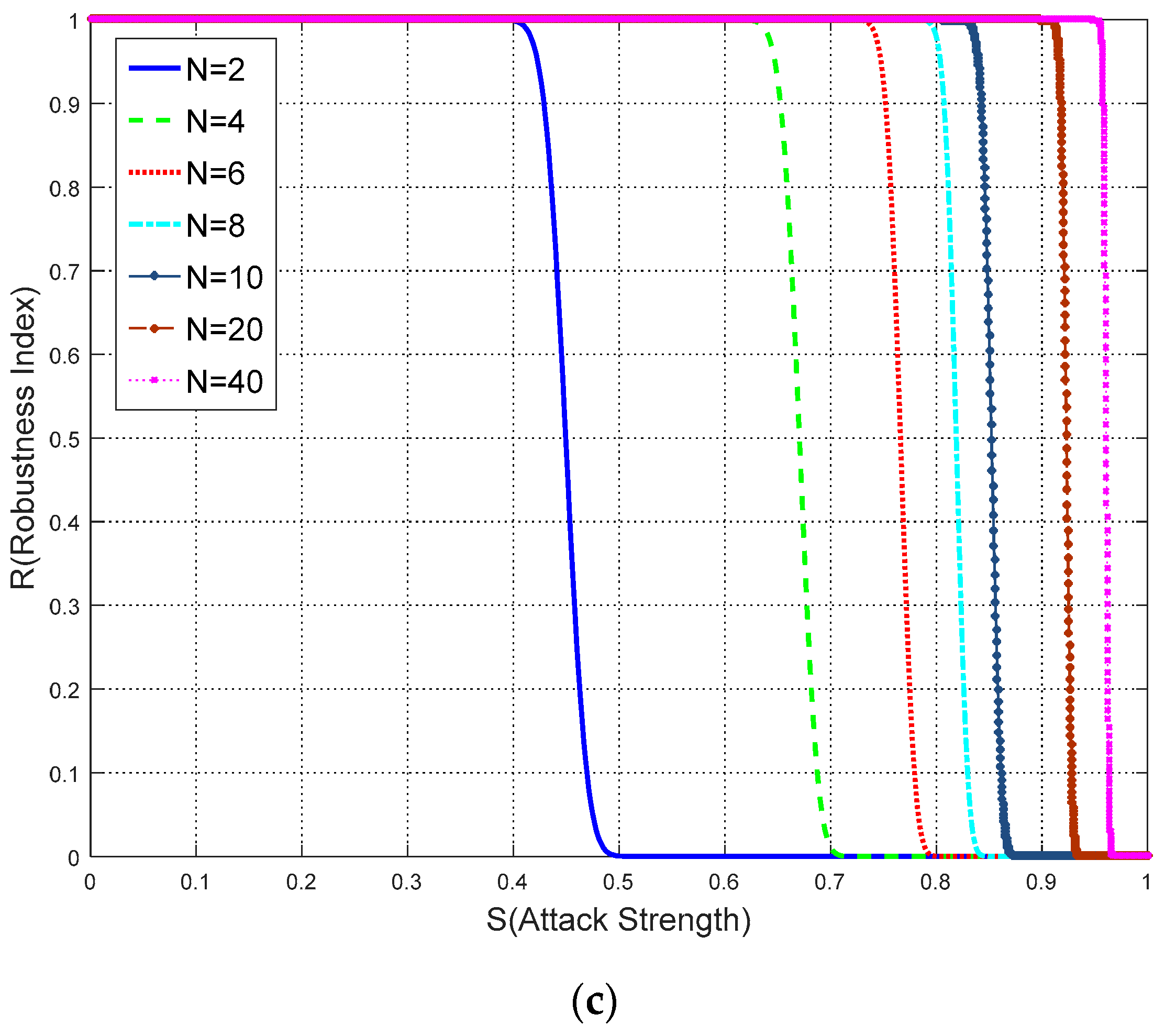
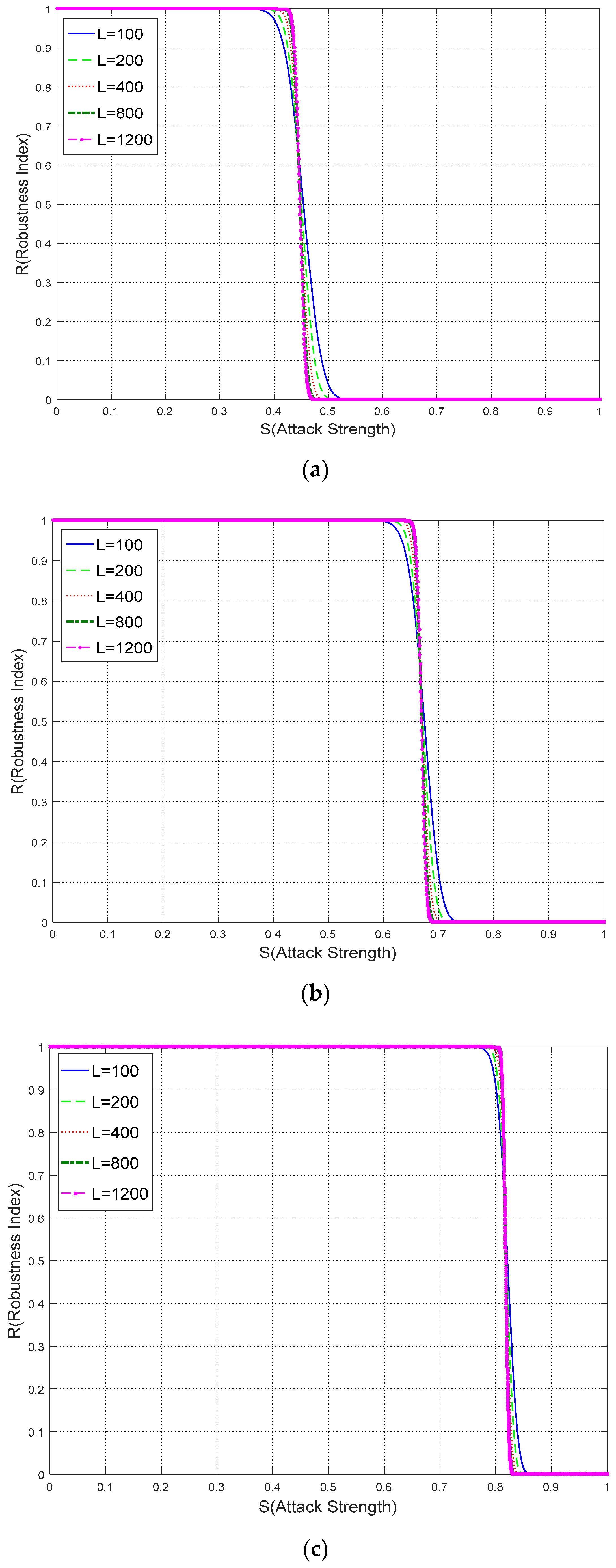
| Experiments | Watermark Length (L) | Watermark Repeat Time (N) | Attacking Strength Interval | Comparison Algorithm |
|---|---|---|---|---|
| Experiment 1 | 200 | 4 | 1/800 | Algorithm A [11] |
| Experiment 2 | 400 | 5 | 1/2000 | Algorithm B [8] |
| Experiment 3 | 300 | 6 | 1/1800 | Algorithm C [10] |
| S (Attack Strength) | R (Robustness Index) | S (Attack Strength) | R (Robustness Index) | ||
|---|---|---|---|---|---|
| Proposed Model | Algorithm A | Proposed Model | Algorithm A | ||
| 0.2000 | 1 | 1 | 0.6700 | 0.5360 | 0.5530 |
| 0.5000 | 1 | 1 | 0.6800 | 0.3018 | 0.3090 |
| 0.6000 | 1 | 1 | 0.6900 | 0.1247 | 0.1350 |
| 0.6100 | 0.9996 | 1 | 0.7000 | 0.0351 | 0.0420 |
| 0.6200 | 0.9980 | 0.9970 | 0.7100 | 0.0100 | 0.0050 |
| 0.6300 | 0.9905 | 0.9890 | 0.7200 | 0.0006 | 0.0010 |
| 0.6400 | 0.9645 | 0.9640 | 0.7300 | 0 | 0 |
| 0.6500 | 0.8945 | 0.9140 | 0.7400 | 0 | 0 |
| 0.6600 | 0.7516 | 0.7630 | 0.7500 | 0 | 0 |
| S (Attack Strength) | R (Robustness Index) | S (Attack Strength) | R (Robustness Index) | ||
|---|---|---|---|---|---|
| Proposed Model | Algorithm A | Proposed Model | Algorithm A | ||
| 0.2000 | 1 | 1 | 0.7300 | 0.3493 | 0.3630 |
| 0.5000 | 1 | 1 | 0.7350 | 0.1895 | 0.1800 |
| 0.6800 | 1 | 1 | 0.7400 | 0.0832 | 0.0670 |
| 0.6900 | 0.9994 | 1 | 0.7450 | 0.0287 | 0.0310 |
| 0.7000 | 0.9910 | 0.9860 | 0.7500 | 0.0076 | 0.0070 |
| 0.7100 | 0.9309 | 0.9300 | 0.7550 | 0.0015 | 0.0010 |
| 0.7150 | 0.8483 | 0.8620 | 0.7600 | 0.0002 | 0 |
| 0.7200 | 0.7145 | 0.7180 | 0.7700 | 0 | 0 |
| 0.7250 | 0.5378 | 0.5350 | 0.7800 | 0 | 0 |
| S (Attack Strength) | R (Robustness Index) | S (Attack Strength) | R (Robustness Index) | ||
|---|---|---|---|---|---|
| Proposed Model | Algorithm A | Proposed Model | Algorithm A | ||
| 0.2000 | 1 | 1 | 0.7650 | 0.5427 | 0.5430 |
| 0.5000 | 1 | 1 | 0.7700 | 0.3583 | 0.3430 |
| 0.7300 | 0.9990 | 0.9980 | 0.7750 | 0.1987 | 0.2010 |
| 0.7350 | 0.9966 | 0.9960 | 0.7800 | 0.0898 | 0.0810 |
| 0.7400 | 0.9892 | 0.9900 | 0.7850 | 0.0319 | 0.0360 |
| 0.7450 | 0.9698 | 0.9690 | 0.7900 | 0.0087 | 0.0060 |
| 0.7500 | 0.9265 | 0.9210 | 0.7950 | 0.0017 | 0.0020 |
| 0.7550 | 0.8445 | 0.8390 | 0.8 | 0.0002 | 0 |
| 0.7600 | 0.7142 | 0.7120 | 0.805 | 0 | 0 |
| Experiments | Max | Mean | Std |
|---|---|---|---|
| Experiment 1 | 0.0396 | 0.0002 | 0.0028 |
| Experiment 2 | 0.0390 | −0.0001 | 0.0027 |
| Experiment 3 | 0.0365 | −0.0001 | 0.0025 |
| Experiments | Proposed Model | Watermarking Algorithms | ||
|---|---|---|---|---|
| Time | Data Volume | Time | Data Volume | |
| Experiment 1 | 1175 s | <1 MB | 20,576 s | ≈601,000 MB |
| Experiment 2 | 3298 s | <1 MB | 67,510 s | ≈601,000 MB |
| Experiment 3 | 1790 s | <1 MB | 24,792 s | ≈601,000 MB |
© 2018 by the authors. Licensee MDPI, Basel, Switzerland. This article is an open access article distributed under the terms and conditions of the Creative Commons Attribution (CC BY) license (http://creativecommons.org/licenses/by/4.0/).
Share and Cite
Tong, D.; Ren, N.; Shi, W.; Zhu, C. A Computational Model of Watermark Algorithmic Robustness Capable of Resisting Image Cropping for Remote Sensing Images. Sensors 2018, 18, 2096. https://doi.org/10.3390/s18072096
Tong D, Ren N, Shi W, Zhu C. A Computational Model of Watermark Algorithmic Robustness Capable of Resisting Image Cropping for Remote Sensing Images. Sensors. 2018; 18(7):2096. https://doi.org/10.3390/s18072096
Chicago/Turabian StyleTong, Deyu, Na Ren, Wenzhong Shi, and Changqing Zhu. 2018. "A Computational Model of Watermark Algorithmic Robustness Capable of Resisting Image Cropping for Remote Sensing Images" Sensors 18, no. 7: 2096. https://doi.org/10.3390/s18072096
APA StyleTong, D., Ren, N., Shi, W., & Zhu, C. (2018). A Computational Model of Watermark Algorithmic Robustness Capable of Resisting Image Cropping for Remote Sensing Images. Sensors, 18(7), 2096. https://doi.org/10.3390/s18072096






